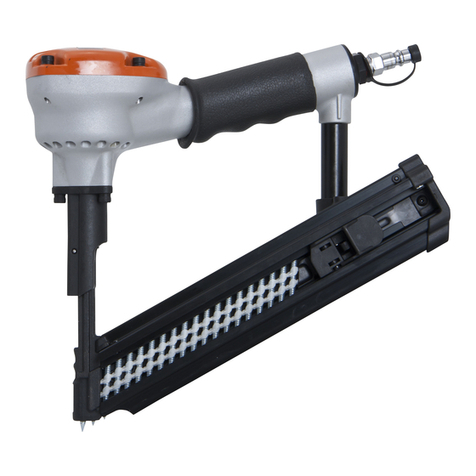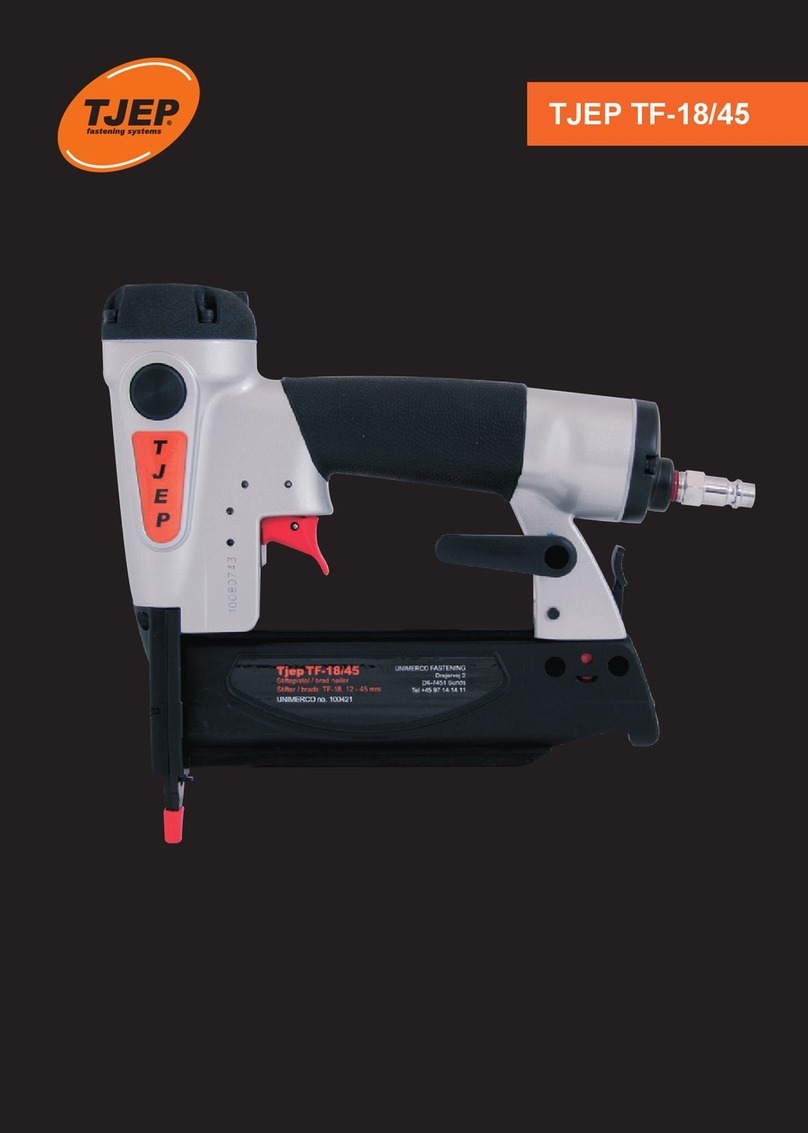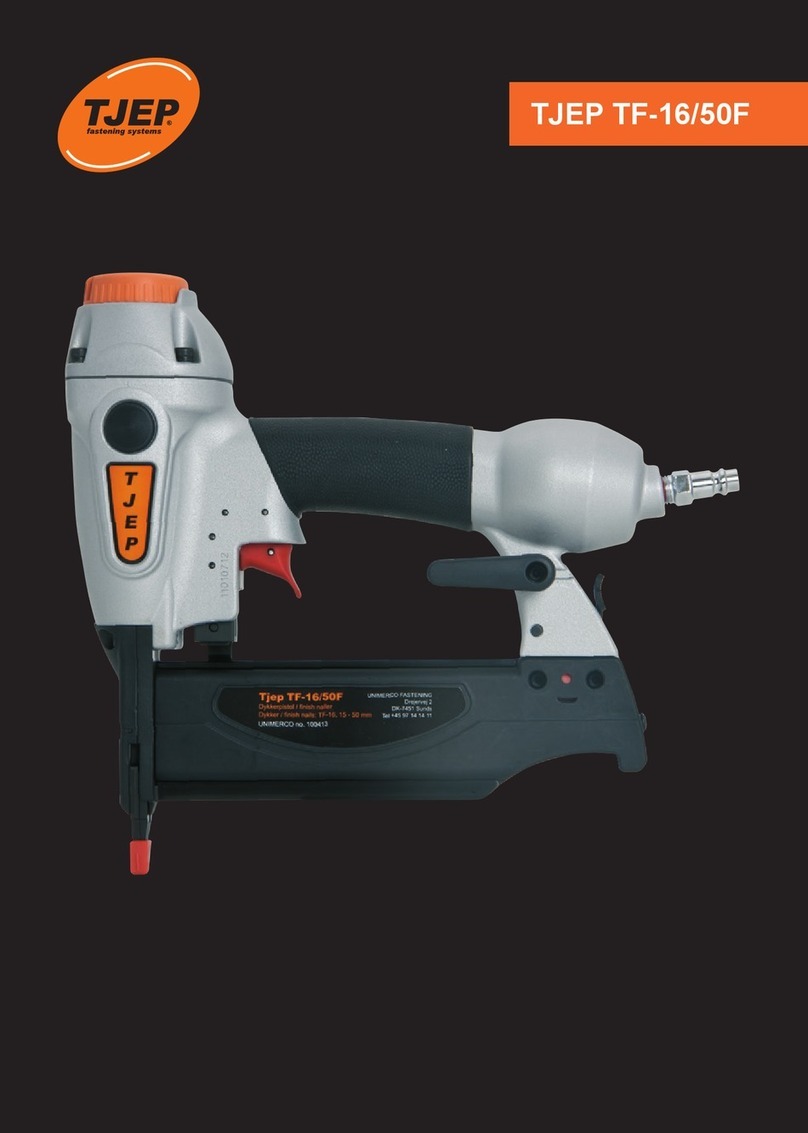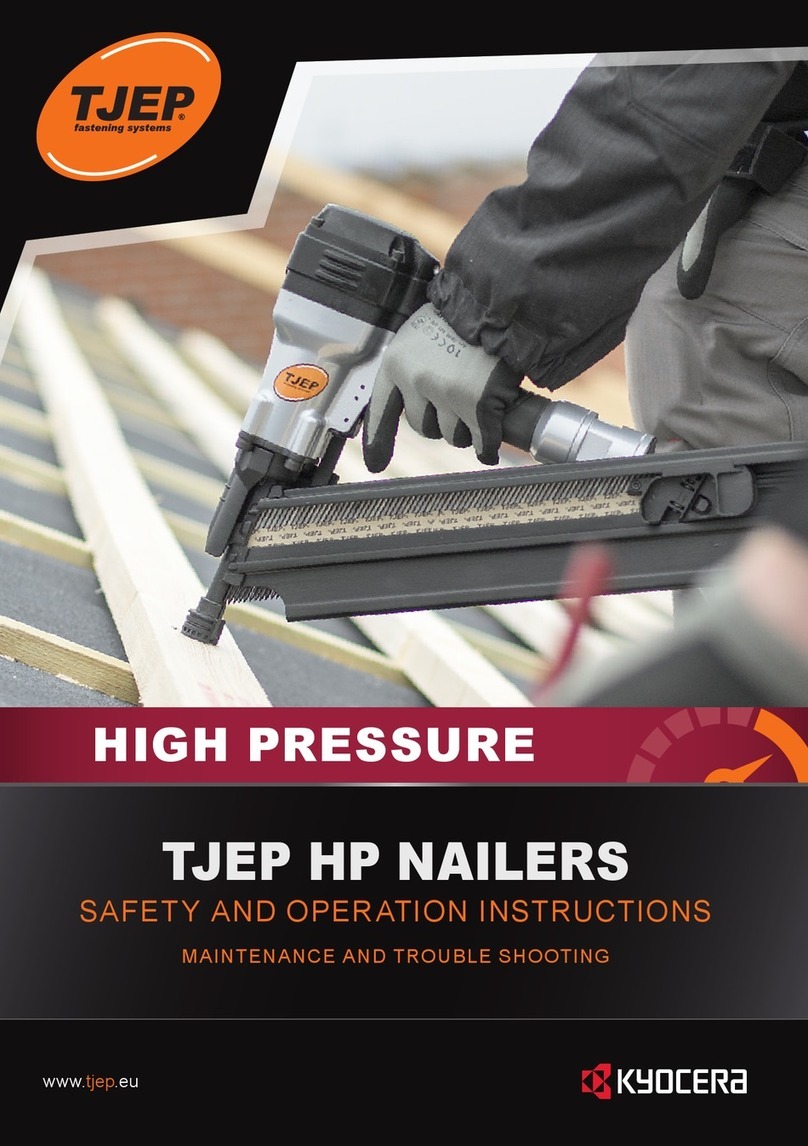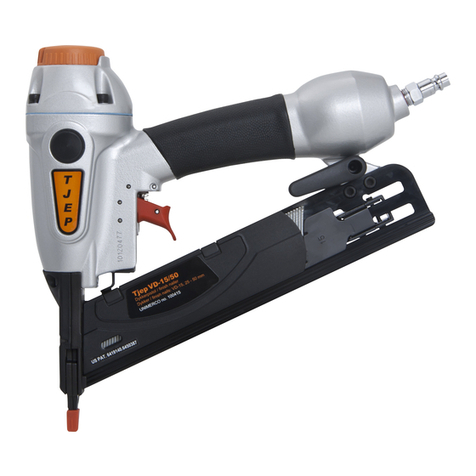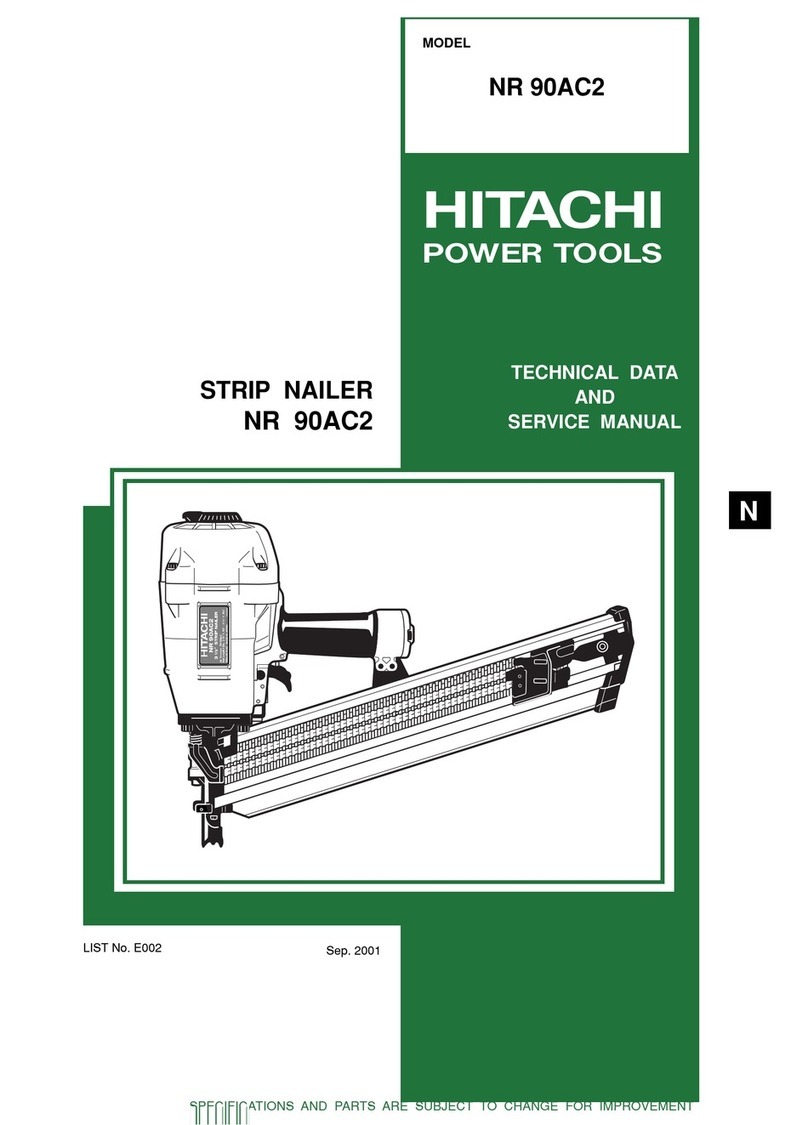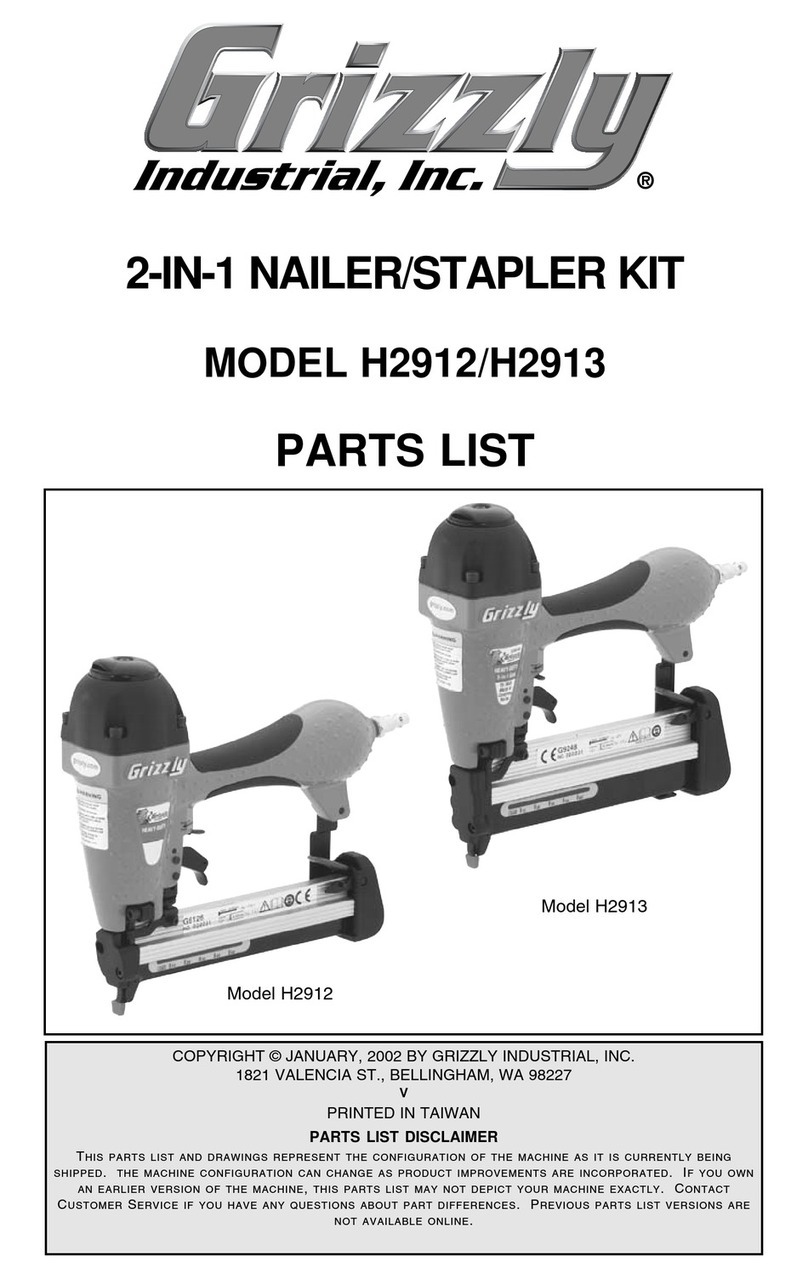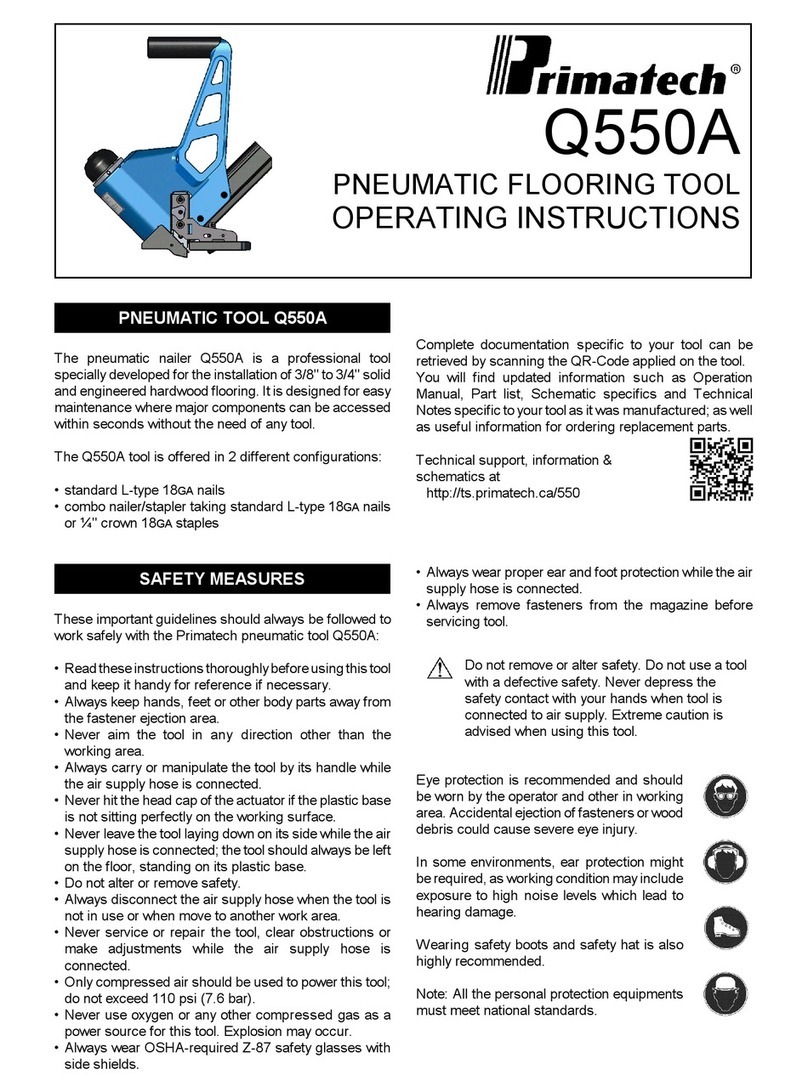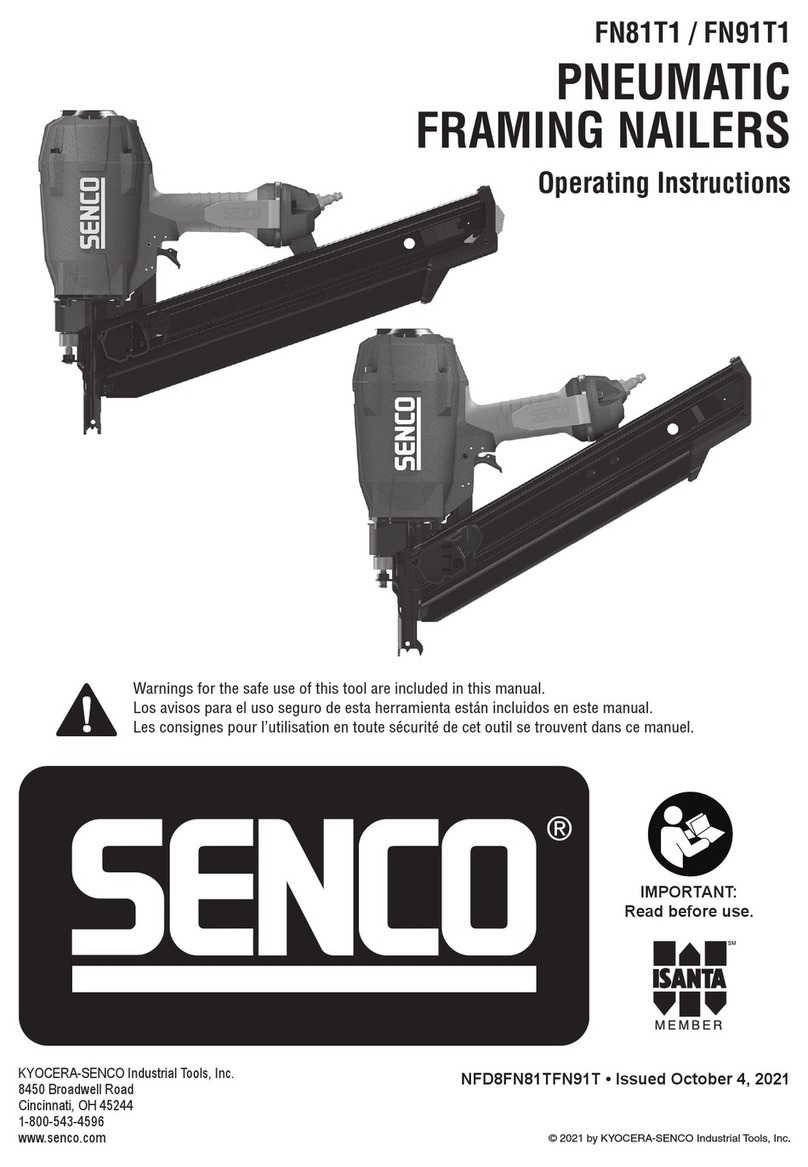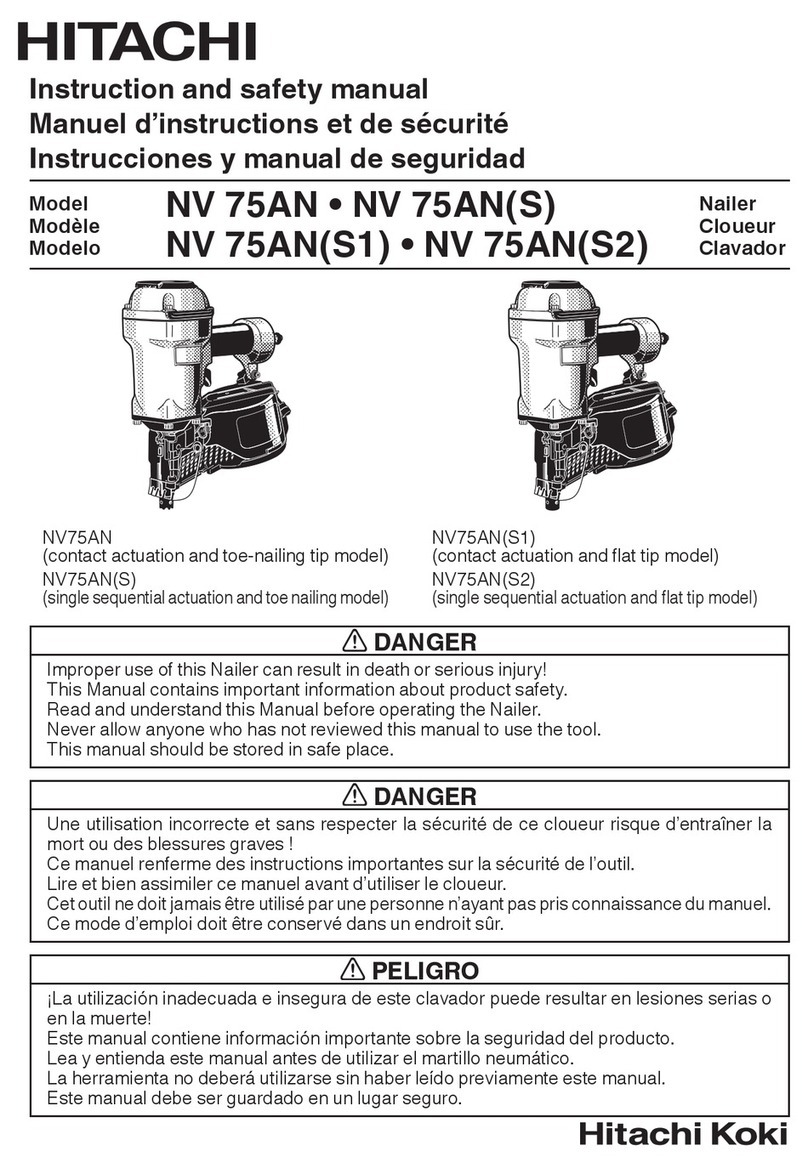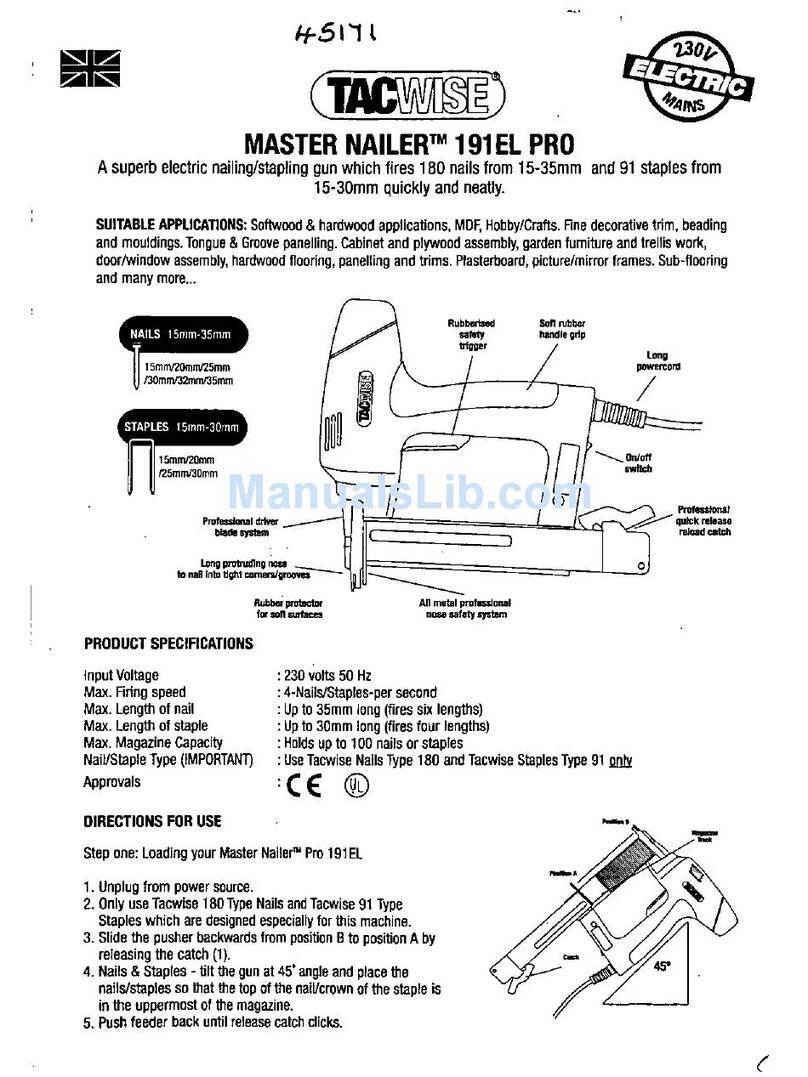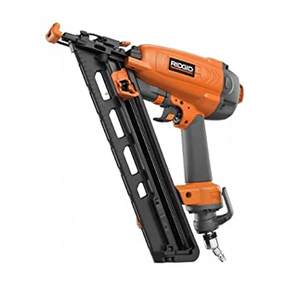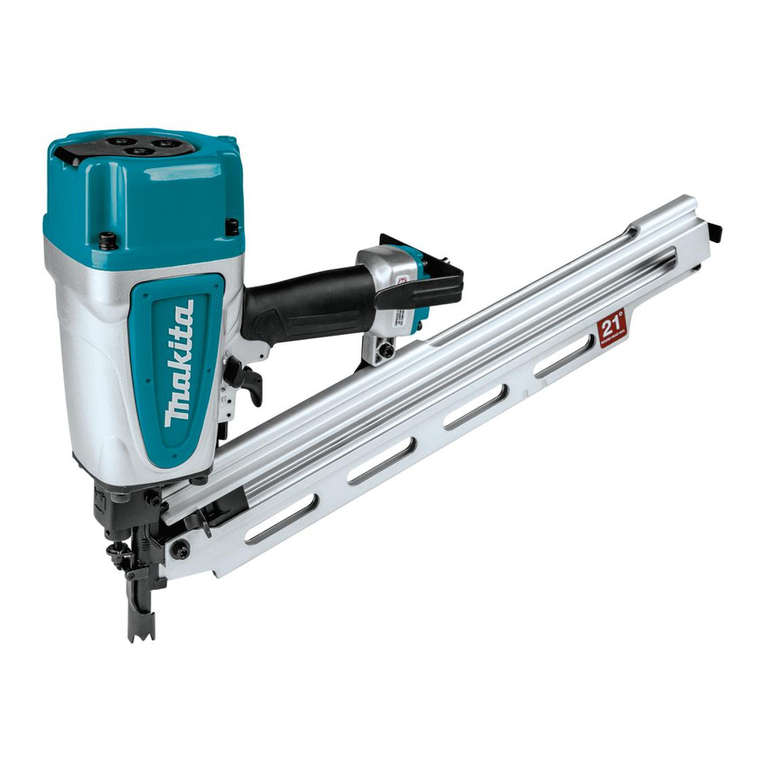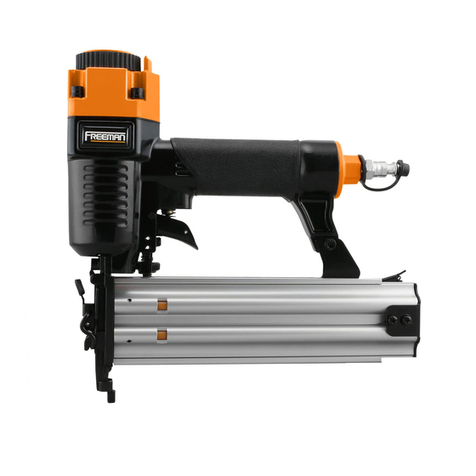TJEP LB-18 T-NUT User manual

- 1 -
1
OPERATION and MAINTENANCE MANUAL
MODEL : TJEP LB-18 T-NUT
NAILER
DRIVES 11,5-18MM (7/16”-3/4”) T-NUTS
,!
WARNING:
BEFORE OPERATING THIS TOOL, ALL OPERATORS SHOULD STUDY MANUAL
TO UNDERSTAND AND FOLLOW THE SAFETY WARNINGS AND INSTRUCTIONS.
KEEP THESE INSTRUCTIONS WITH THE TOOL FOR FUTURE REFERENCE. IF
YOU HAVE QUESTIONS, CONTACT YOUR DISTRIBUTOR.

- 2 -
2
INTRODUCTION
The pneumatic tools is a precision-built tool, designed for high speed, high volume
fastening. These tools will deliver efficient, dependable service when used correctly, and
with care. As with any fine power tool for best performance the manufacture’s
instructions must be followed. Please study this manual before operating the tool and
understand the safety warning and cautions. The instructions on installation, operation
and maintenance should be read, carefully, and the manual kept for reference. NOTE:
Additional safety measures may be required because of your particular application of
the tool. Contact your representative or distributor with any questions concerning the
tool and its use.
INDEX
INTRODUCTION…………………………..……………………………………………….….1
SAFETY INSTRUCTIONS………………………………………………………………….…2
AIR SYSTEMS……………………………………………………………………………….…5
TOOL INSTALLATION……………………………………………………………………..…7
TOOL LOADING….……………………………………………………………………………8
TOOL OPERATION…………………………………………………………………………….9
MAINTENANCE…………………………………………………………………………….….10
OPERATOR TROUBLESHOOTING…………………………………………………………14
TOOL SPECIFICATIONS
MODEL LENGTH WIDTH HEIGHT WEIGHT
CAPACITY
TJEP LB-18
322 mm
(12 11/16“) 403mm
(15 7/8“) 81mm
(3 3/16“) 3.2kg
(7,1lbs) 13 T-NUTS
FASTENER SPECIFICATIONS:
MODEL T-NUT SIZE DIAMETER BARREL LENGTH
TJEP LB-18
23×21mm
(7/8”
×13/16”)
M6, M8, M10
(1/4”, 5/16”, 3/8”) 11,5-18mm
(7/16”-3/4”)
TOOLAIR FITTING
This tool uses a 1/4” N.P.T male plug. The inside diameter should be .200”(5mm) or larger.
The fitting must be capable of discharging tool air pressure when disconnected from the
air supply.
OPERATING PRESSURE
70 to 110 p.s.i. (4,9 to 7,8kg/
2
) Select the operating pressure within this range for best
fastener performance.
DO NOT EXCEED THIS RECOMMENDED OPERATING PRESSURE.
NOISE CHARACTERISTIC VALUES IN ACCORDANCE WIT Enxxl:
A-weighted single-event sound pressure level at operator’s :L
PA
,2s= 89 dBA
A-weighted single-event sound power lever :L
WA
,1s= 98 dBA
A-weighted single-event surface sound pressure level :L
PA
,1s,1m= 85 dBA
VIBRATION CHARACTERISTIC VALUES IN ACCORDANCE WITH ISO 8662;
PART11:
Weighted root mean square acceleration: 3,01 m/s
2

- 3 -
3
SAFETY INSTRUCTIONS
SAFETY FIRST
These safety instructions provide information necessary for safe
operation of pneumatic tools. DO NOT attempt to operate the tool until
you read and understand all safety precautions and manual instructions.
WEAR EYE AND HEARING PROTECTION
Always wear hearing and eye protection devices, including side
shields when operating or working in the vicinity of a tool.
THE TOOL MUST BE USED ONLY FOR THE PURPOSE
FOR WHICH IT WAS DESIGNED
Do not throw the tool on the floor; strike the housing in any way or
the tool as a hammer to knock material into place.
NEVER ENGAGE IN HORSEPLAY WITH THE TOOL
The tool is not a toy so do not use it like one. Never engage in
horseplay with the tool or point it at yourself or any person, even if
you think it is not loaded.
NEVER ASSUME THE TOOL IS EMPTY
Check the magazine for fasteners that may be left in the tool. Even if
you think the tool is empty or disconnected never point it at anyone
or yourself. Unseen fasteners could fire the tool.
NEVER CLAMP THE TRIGGER IN A LOCKED OR
OPERATING POSITION
The trigger of the tool must never be tampered with; disabled or
clamped in a locked or operating position since this will cause the
tool to driver a fastener any time the work contacting element is
depressed.
DO NOT LOAD FASETNERS WITH THE AIR LINE
CONNECTED, OR WITH THE TOOL TRIGGER OR
WORK CONTACTING ELEMENT DEPRESSED
When loading fasteners into the tool, make sure to disconnect the air
line and not to depress the trigger or work contacting element.

- 4 -
4
SAFETY INSTRUCTIONS
OPERATE THE TOOL ONLY ON A WORKPIECE
The tool should be operated only when it is in contact with the work
piece. Even then you should be careful when fastening thin material
or working near the edges and corners of the work piece since the
fasteners may drive through or away from the work piece.
DO NOT DISABLE OR REMOVE THE WORK
CONTACTING ELEMENT
This tool is equipped with a safety mechanism, called a work
contacting element, to help prevent accidental firing. Never tamper
with, disable or remove the work contacting element. Do not use the
tool unless the work contacting element is working properly. The
tool could fire unexpectedly.
DISCONNECT THE TOOL WHEN NOT IN USE
Always disconnect the tool from the air line when it is not used or
when you leave the work area. The tool should never be left
unattended because people who are not familiar with the tool might
handle it and injure themselves or others.
CARRY THE TOOL ONLY BY THE HANDLE
Always carry the tool by the handle only. Never carry the tool by the
air hose or with the trigger depressed since you could drive a
fastener unintentionally and injure yourself or someone else.
DO NOT WEAKEN THE TOOL HOUSING
The tool housing is a pressure vessel and should never be weakened
by having your company’s name, area of work or anything else
stamped or engraved into its surface.
DISCONNECT THE TOOL WHEN PERFORMING
REPAIRS AND CLEARING JAMS
Never attempt to clear a jam or repair a tool unless you have
disconnected the tool from the air line and removed all remaining
fasteners from the tool.

- 5 -
5
SAFETY INSTRUCTIONS
ALWAYS USE THE PROPER FITTING FOR THE TOOL
Only MALE pneumatic type air connectors should be fitted to the
tool, so that high pressure air in the tool is vented to atmosphere as
soon as the air line is disconnected.
NEVER install FEMALE quick disconnect couplings on the tool.
Female couplings will trap high pressure air in the tool when the air
line is disconnected, leaving the tool charged and able to drive at
least one fastener.
DO NOT EXCEED THE MAXIMUM RECOMMENDED
AIR PRESSURE
Operate the tool only at the recommended air pressure. Do not
exceed the maximum air pressure marked on the tool. Be sure the
air pressure gauge is operating properly and check it at least twice a
day.
Never use any bottled air or gases such as oxygen to operate the tool
since they could cause the tool to explode.
KEEP THE TOOL CLEAN AND LUBRICATED
Clean the tool at least daily and lubricate as required. Never operate
a dirty or malfunctioning tool.
USE ONLY RECOMMENDED PARTS AND FASTENERS
Use only parts and fasteners specifically designed and recommended
for use in the tool and for the work to be done. Using unauthorized
parts and fasteners or modifying the tool in any way creates
dangerous situations. Replace all missing parts-refer to tool
schematic for correct placement and part number.
,! DANGER
,!
Failure to follow any of the above instructions could result
in severe personal injury to tool user and bystanders or cause
damage to tool and property.

- 6 -
6
AIR SYSTEMS
For air-powered tools to work their best, the air supply system must be
properly installed and maintained regularly. A drawing in this section
shows a properly installed air supply system. Handy checklists for
installing and maintaining air supply systems follow.
INDOOR AIR SYSTEM INSTALLATION BE CERTAIN
THAT:
All pipes supplying air have a large enough inside diameter to
ensure adequate air supply.
The main supply pipe slopes down, away from the compressor
(1/16 inch per foot).
Air storage is provided along lengthy air lines.
Pipe line branch outlets are at the top of the main pipe line.
Cut-off valves are provided at each branch pipe line throughout
the system.
Water legs extend from the bottom of each branch line.
A refrigerant-type dryer is installed on the system.
Air hoses are kept as short as practical.
A regular maintenance program is followed.
QUTDOOR AIR SYSTEM INSTALLATION BE CERTAIN
THAT:
A moisture trap and a filter/regulator/lubricator are installed at
the compressor.
Air hoses and fittings are large enough so that air flow not
restricted. Minimum hose size is 3/8 inch ID, with 1/2 inch ID hose
used for any application over 25 feet.
Air hoses are not longer than 150 feet.

- 7 -
7
AIR SYSTEMS
The air system is lubricated regularly.
A regular maintenance program is followed.
FILTER/REGULATOR/LUBRICATOR UNITS:
Filter/regulator/lubricator units that can supply enough air and
protection for pneumatic tools must meet the following
specifications:
Minimum 3/8 inch NPT port size.
50 micron or finer filters.
Regulated pressure from zero to 120 psi.
Lubricators designed for low or changing airflow.

- 8 -
8
TOOL INSTALLATION
,
!
DANGER ,
!
Air pressure at the tool must never exceed
120 psi.
Your pneumatic tool comes ready for immediate use and can be installed
by following these steps:
i. SAFETY-All tool operators and their immediate supervisors must
become familiar with the operator safety instructions before operating
the tool. The instructions are on page 2 of this manual.
ii. Included with each tool are one copy of this Safety and Maintenance
manual and one copy of the Tool Schematic. Keep these publications
for future reference.
iii. The plastic cap in the air inlet of the tool must be removed before the
male air fitting is installed. The fitting must be a male pneumatic type
that discharges the air from the tool when the air line is disconnected.
iv. Install a filter/regulator/lubricator unit with a gauge as close as
practical to the tool, preferably within ten feet. Refer to the Air
Systems section of this manual for air hose requirements and lengths.
In general, no other special installation is required.
v. If the operator is working at a bench or table, it is usually best to run
the air line underneath the bench. A small tray under the benchtop can
hold the fastener supply and the tool when not in use.
vi. If this tool does not work when it is first connected, do not try to make
repairs. Call your local service center immediately.
,
!
DANGER ,
!
Air pressure at the tool must never exceed
120 psi.

- 9 -
9
TOOL LOADING
,
!
WARNING ,
!
Never point the tool at yourself and others
in work area.
i. Hold the tool handle firm, pull the pusher backward to the end of
magazine and rotate the pusher downward to position.
ii. Insert T-nut strips from rear of magazine.
iii. Slide the T-nut strip forward in the magazine.
iv. Pull the pusher upright, slide it forward slowly and gently to engage
the T-nut strip and be sure the first T-nut is protruded from the nose.

- 10 -
10
v. The tool is now ready to operate.
TOOL OPERATION
SEQUENTIAL OPERATION:
The sequential operating prevents successive or “bounce” driving.
Depress the work contacting element and hold it against the work
surface before pulling the trigger.
After each fastener is driven, completely release the trigger and
lift the tool from the work surface.
OPERATING THE TOOL:
Be sure to locate and insert the first T-nut barrel into the
pre-drilled hole of work piece with finger off the trigger.
Depress the tool vertically and pull the trigger to drive a T-nut.
Remove finger from the trigger and lift the tool from the work
piece.
Repeat the same procedure for next T-nut.
When change the T-nut size, remove the remaining T-nuts inside
the magazine.
For best result to operate the tool:
When tool/T-nut is located in hole, pull the tool backwards
(toward yourself) and pull the trigger.

- 11 -
11
MAINTENANCE
These tools are built for ease of maintenance. A few simple details will
assure trouble-free operation and long tool life. Anyone who uses or
maintains the tool must read the safety and maintenance instructions.
Study the schematic drawing before starting any repairs on the tool.
Air-operated tools must be inspected periodically, and worn or broken
parts must be replaced to keep the tool operating safety and efficiently.
Also the item on the maintenance chart must be checked often.
COLD WEATHER CARE
When temperatures are below freezing, tools should be kept warm
by any convenient, safe method. If this is not possible, the following
procedure should be used to warm up the tool parts.
Reduce the regulated air pressure to 30 psi.
Remove all fasteners from the tool.
Collect an air line and blank fire the tool. The reduced air
pressure will be enough to free-fire the tool. Slow speed operation
tends to warm up the moving parts. Slowing up the piston helps
bumper and the O-rings to become springy.
,
!
CAUTION ,
!
Never free-fire the tool at high pressure.

- 12 -
12
Once the tool is warmed up, readjust the regulator to the proper
working pressure and reload the tool.
Tool operators working outdoors or in unheated areas in
extremely cold temperatures.
Use recommended air tool oil with antifreeze in the lubricator.
MAINTENANCE
Once a week, depending on the amount of tool use, take the tool
apart and wash away any sludge with degreaser cleaner parts to
keep the tool operating efficiently.
,
!
CAUTION ,
!
Never use kerosene or flammable solvents
to clean the tool.
Cleaning air-operated tools with solvents remover the thin coating of
grease applied to the cylinder wall and ”O” rings at the factory. To
replace this coating of grease, use LITHIUM grease or equivalent on
parts.
Open the drain on the air compressor tank to drain any moisture
at least daily in extremely cold or humid weather. A few ounces of
anti-freeze in the tank will keep the air free of frost.
TESTING THE TOOLAFTER SERVICING
After replacing any part or parts, it is important to check the tool
for proper operation. This ensures that the tool was put together
correctly, is safe to use, and will perform the job properly.
Ensure that all hardware is tight.
Ensure that the work contacting element is installed correctly in
relation to the trigger, and that both parts move freely.
Ensure that the magazine is properly attached.
Ensure that the required safety information on the tool is legible.

- 13 -
13
Use only approved fasteners in the tool, and ensure that they are
correct for the application.
Ensure that a male air fitting is securely connected to the tool.
Test the tool by driving fasteners into a workpiece identical to the
tool’s application.
Check the tool for air leaks during testing and for the proper
sequence of operation.
Ensure that all fasteners are driven to the same depth and that the
crown of the fastener is flush with the workpiece.
MAINTENANCE
TOOL LUBRICATION
It is most important that the tool be properly lubricated by keeping
the air line lubricator filled and correctly adjusted. Without proper
lubrication the tool will not work properly and parts will wear
prematurely.
Use the proper lubricant in the air line lubricator. The lubricator
should be of the low air flow or changing air flow type, and should
be kept filled to the correct level. Use only recommended lubricants.
Substitutes may harm the rubber compounds in the tool “O” rings
and other rubber parts.
If a filter/regulator/lubricator is not installed on the air system,
air-operated tools should be lubricated at least once a day with 6 to
20 drops of oil, depending on the work environment, directly
through the male air fitting in the tool housing.
Most minor problems can be resolved quickly and easily using the
maintenance table that follows. If problems persist, contact your
local dealer for assistance.
MODEL IDENTIFICATION
Refer to Operation instructions on page 9 before proceeding to use
this tool.

- 14 -
14
MAINTENANCE
,
!
CAUTION
,
!
Disconnect the tool when performing
repairs.
MAINTENANCE TABLE
ACTION WHY HOW
Drain air line filter
(daily). Prevent accumulation
of moisture and dirt. Open manual petcock(
most air supply systems
have such a valve).
Keep lubricator filled. Keep tool lubricated. Fill with recommended
air tool lubricant
Clean filter element-
then
blow air through filter in
direction opposite to
normal flow.
Prevent clogging of
filter with dirt. Wash with soap and
water or follow
manufacture’s
instructions.
Check that all screws on
tool are tight. Prevent air leakage
and promote efficient
tool operation.
Check screw daily.
Keep work contacting
element working
properly.
Promote operator
safety and efficient
tool operation.
Blow clean daily.
Keep magazine and Prevent jamming of Blow clean daily.

- 15 -
15
feeder mechanism clean.
fasteners.
Lubricate ”O” rings that
are replaced. Assure long life and
proper operation of
tool.
Use lithium grease or
equivalent.
Use only recommended
replacement parts. Keep tool operating
efficiently. Order any replacement
parts needed from local
service center dealer.
OPERATOR TROUBLESHOOTING
,
!
CAUTION
,
!
Disconnect the tool when performing
repairs.
PROBLEM CORRECTIVE ACTION
T-nuts will not drive completely into
wood. Increase air pressure (do not exceed 120
psi).
T-nuts penetrate properly during normal
operation, but won’t drive fully at faster
speeds.
Increase air flow to tool-
use larger air lines
(3/8 inch ID minimum).
T-nuts drive too deeply into wood. Reduce air pressure.
Tool can’t fire. Check magazine for proper T-nuts. T-nuts
should slide freely with no follower
pressure.
Increase air pressure (do not exceed 120
psi).
Air leaks at cap when tool is connected to
air. Tighten cap screws.

- 16 -
16

- 17 -
17

- 18 -
18

- 19 -
19
Table of contents
Other TJEP Nail Gun manuals
